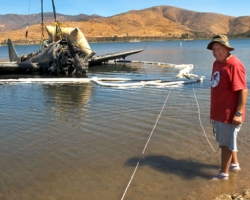
The World War II SB2C-4 Helldiver that was discovered last year by two fishermen using a Humminbird fishfinder was pulled Aug. 20 from the lower Otay Lake Reservoir.
Submerged in nearly 90 feet of water, the plane was ditched due to engine problems by Navy pilot E.D. Frazar on May 28, 1945.
The relic was nicknamed by crew members “The Big-Tailed Beast,” as it was difficult to fly and crashed often. The plane weighed 11,000 pounds empty and more than 16,600 pounds loaded, and could reach up to 281 mph with a range of 1,110 miles.
Neither Frazar nor his backseat gunner Joseph Metz were injured that day, although both have since passed away.
The Helldiver was ordered into large-scale production in 1940 and made its first flight Dec. 18. On Nov. 11, 1943, it went into action participating in a heavy raid on the major Japanese base of Rabaul.
Plans to extract the Helldiver were delayed one day, according to general manager and diver Taras Lyssenko of A&T Recovery, who oversaw the project.
“The biggest challenge was having to deal in a biodome,” Lyssenko said. “We also had to follow city rules that wouldn’t allow us to work under our conditions.”
Diver Keith Pearson has worked with A&T for more than 20 years and said it’s important to always be prepared for alternate plans.
“This plane was completely buried in water with only a foot or two of visibility,” he said. Pearson said it was like going in blind.
“Salvaging is not a science, it’s an art,” Lyssenko said.
According to Lyssenko, the value of the Helldiver is around $500,000. A significant amount of money is saved because retired veterans volunteer their time to work on restoring and salvaging the plane.
Jim Kidrick, president and CEO of the San Diego Air & Space Museum, said the significance of the Helldiver is that it’s a rarity.
“I believe there are only about five left in the world,” he said. “It’s like one piece to a huge puzzle. We are very fortunate to have a community of world-class restorers,” Kidrick said.
Developed to replace the Douglas SBD Dauntless, the Helldiver was a carrier-based dive-bomber aircraft produced for the United States Navy during World War II. It was a significantly larger and faster aircraft capable of holding a considerable array of weapons.
“The Navy does not have a single one of these planes in their collection,” Lyssenko said.
He added that it’s important to preserve the historical planes to remind people what this country has done.
“The stories behind the aircraft is what’s important,” Lyssenko said. There are so many [veterans] passing away everyday, and it keeps them alive,” he said.














